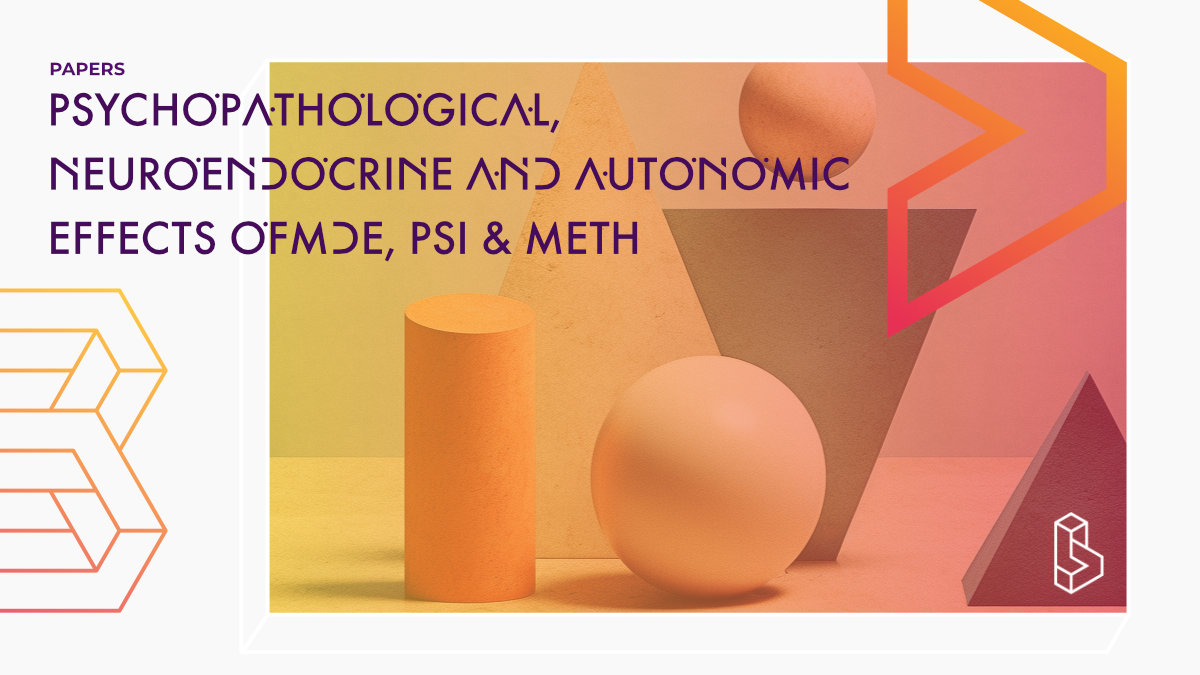This randomized, double-blind, placebo-controlled, between-subjects study (n=32) investigated the effects of MDE (140mg/70kg), psilocybin (14mg/70kg), and methamphetamine (14mg/70kg) on the mental state and the neuroendocrine and autonomic nervous system of healthy participants. The entactogen MDE took an intermediate position between the stimulant methamphetamine and the hallucinogen psilocybin and elicited highly characteristic emotional effects, that were qualitatively different from the effects of the other two drugs, which supports the hypothesis that entactogens constitute a distinct psychoactive substance class.
Abstract of Psychopathological, neuroendocrine and autonomic effects of MDE, psilocybin and Speed in healthy volunteers
“Introduction: The aim of this study was to contribute to the characterization of the entactogen (ecstasy) substance group.
Methods: The psychopathological, neuroendocrine and autonomic effects of common recreational doses of the entactogen 3,4-methylenedioxyethylamphetamine (MDE), the hallucinogen psilocybin, the stimulant d-methamphetamine and placebo were investigated in a double-blind study with healthy volunteers (n = 32). Psychological effects of the drugs were assessed by means of standardized rating scales, self assessment inventories and free descriptions.
Results: The most characteristic effects of MDE were pleasant emotional experiences of relaxation, peacefulness, content and closeness to others. However, significant stimulant and hallucinogen-like effects were also present, although the latter were weaker than the effects of psilocybin. MDE elicited the strongest endocrine and autonomic effects among the three drugs, including robust rises of serum cortisol and prolactin, elevations of blood pressure and heart rate, and a moderate, but significant rise of body temperature.
Discussion: The apparent contrast between psychological and autonomic effects (subjective relaxation versus physical activation) was a unique feature of the MDE state. Our findings are in line with both users’ reports and results from previous experimental studies, and support the view that entactogens constitute a distinct psychoactive substance class taking an intermediate position between hallucinogens and stimulants.”
Authors: Euphrosyne Gouzoulis-Mayfrank, Bernhard Thelen, E. Habermeyer, H. J. Kunert, Karl-Artur Kovar, H. Lindenblatt, Leopold Hermle, Manfred Spitzer & Henning Sass
Summary of Psychopathological, neuroendocrine and autonomic effects of MDE, psilocybin and Speed in healthy volunteers
Materials and methods
Thirty-two healthy volunteers were randomly assigned to one of four drug groups (MDE, psilocybin, d-methamphetamine, placebo), and gave written informed consent. All subjects were physicians (n = 25) or psychologists with a scientific or clinical interest in the study. Subjects were screened by medical history, clinical examination, electrocardiogram, laboratory testing, and standardized psychiatric interview according to DSM-III-R (SCID), supplemented by a clinical interview, and standard psychometric instruments. No subject met DSM-IIIR criteria for alcohol or substance abuse at present or in the past.
All substances were obtained from the Pharmaceutical Institute of the University of Tübingen, and were prepared as capsules of identical appearance. Psilocybin, d-methamphetamine, and MDE were given in the following doses to 8 subjects: 0.2 mg/kg psilocybin, 2 mg/kg MDE, and 17.5 mg d-methamphetamine.
Find this paper
https://doi.org/10.1007/s002130050860
Paywall | Google Scholar | Backup | 🕊
Cite this paper (APA)
Gouzoulis-Mayfrank, E., Thelen, B., Habermeyer, E., Kunert, H. J., Kovar, K. A., Lindenblatt, H., ... & Sass, H. (1999). Psychopathological, neuroendocrine and autonomic effects of 3, 4-methylenedioxyethylamphetamine (MDE), psilocybin and d-methamphetamine in healthy volunteers Results of an experimental double-blind placebo-controlled study: Results of an experimental double-blind placebo-controlled study. Psychopharmacology, 142, 41-50.
Study details
Compounds studied
Psilocybin
Topics studied
Healthy Subjects
Study characteristics
Original
Placebo-Controlled
Active Placebo
Double-Blind
Randomized
Participants
32
Humans
Institutes
Institutes associated with this publication
RWTH Aachen UniversityRWTH Aachen University is a leading technical university located in the city of Aachen, Germany. It did some of the first psychedelic research of the third wave (1998).
Compound Details
The psychedelics given at which dose and how many times
Psilocybin 14 mg | 1xLinked Research Papers
Notable research papers that build on or are influenced by this paper
Neurometabolic effects of psilocybin, (MDE) and d-methamphetamine in healthy volunteersThis re-analysis of an RCT study (n=32) compared the neural correlates FDG-PET (n=8 per group) of MDE (140mg/70kg), psilocybin (14mg/70kg), and methamphetamine (14mg/70kg). The authors found that all three present unique neural profiles. Psilocybin increased regional metabolic rates of glucose (rMRGlu) in right frontotemporal cortical regions and decreased it in the thalamus, while MDE and METH-induced cortical hypometabolism and cerebellar hypermetabolism. Cognitive activation-related increases in left frontocortical regions were attenuated under all three substances but less under MDE, with different mechanisms potentially responsible for these effects across the groups.
